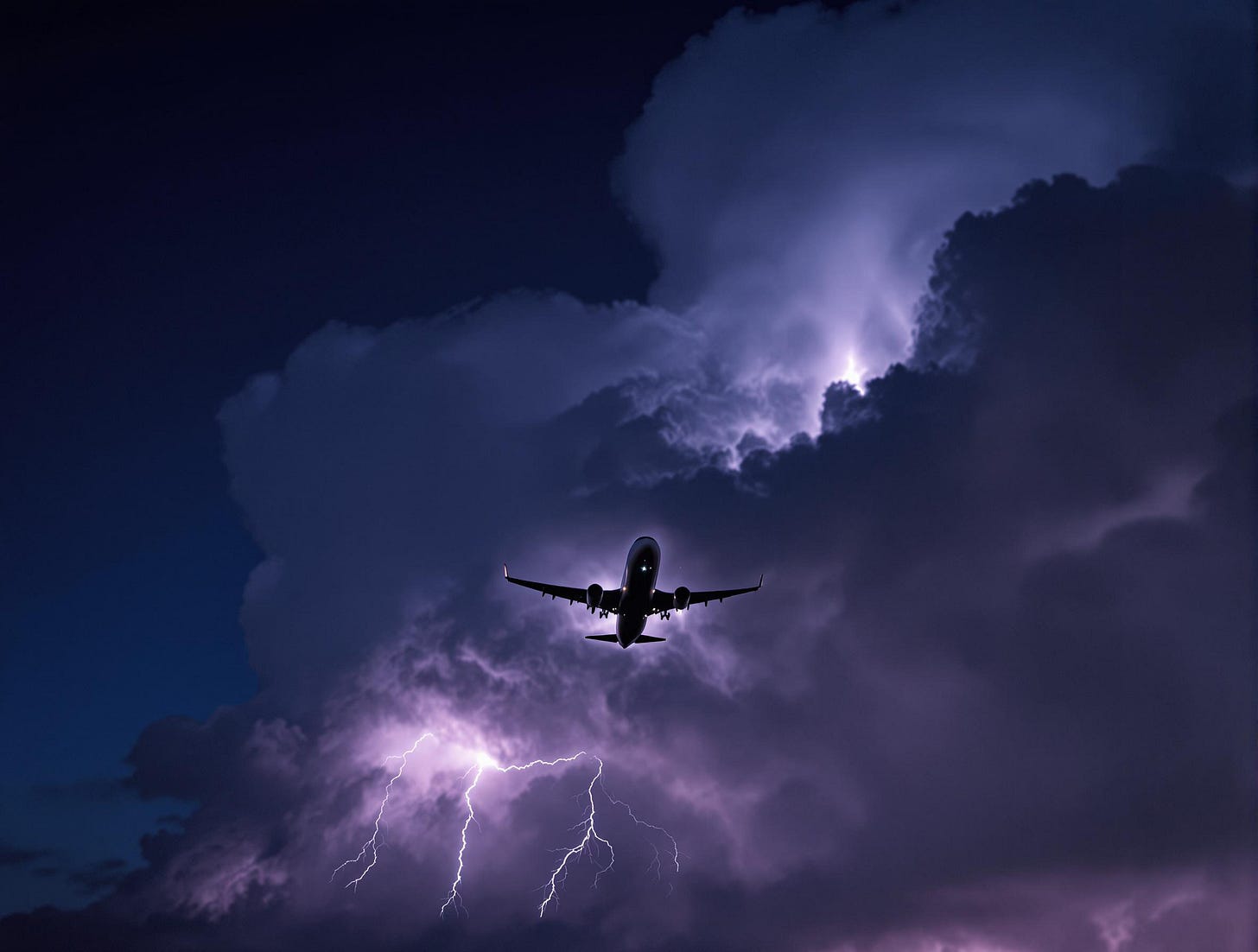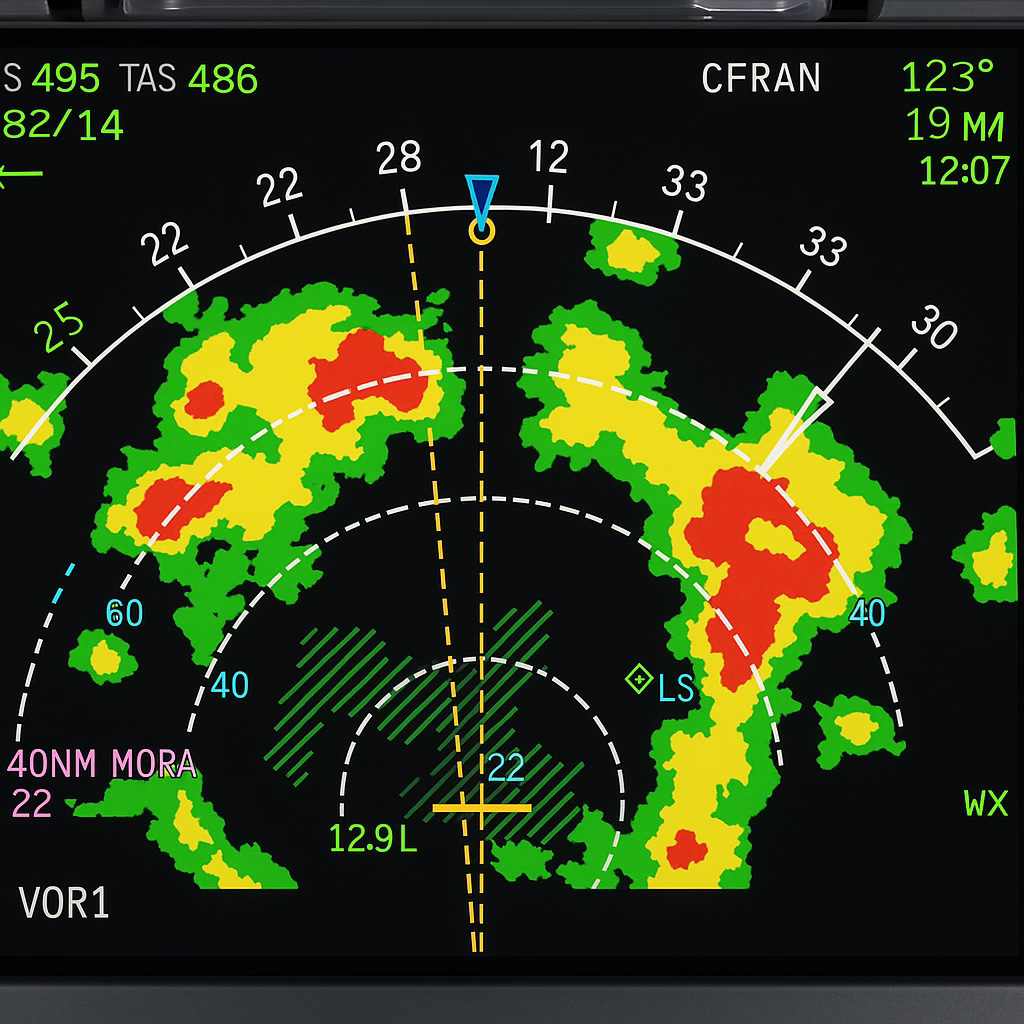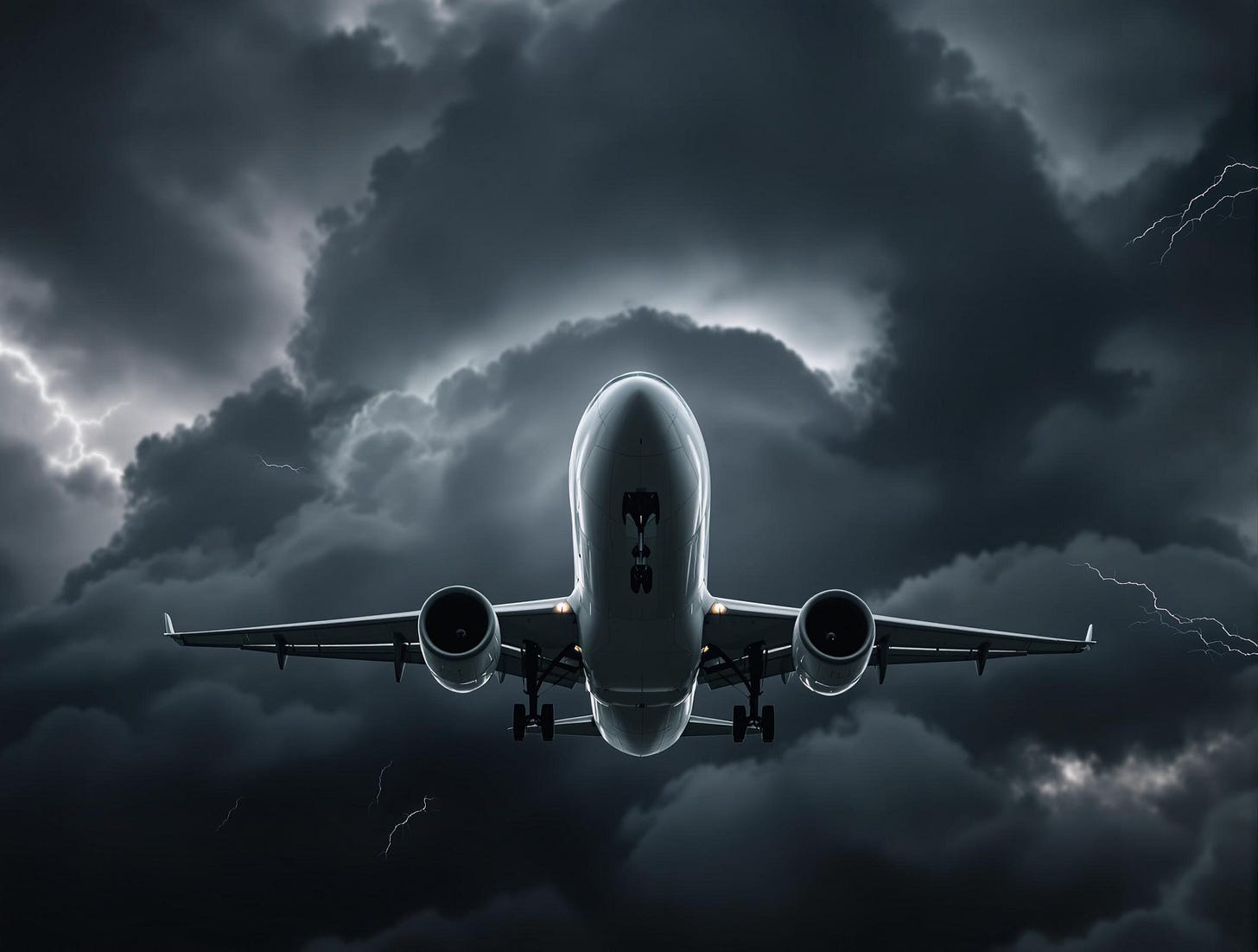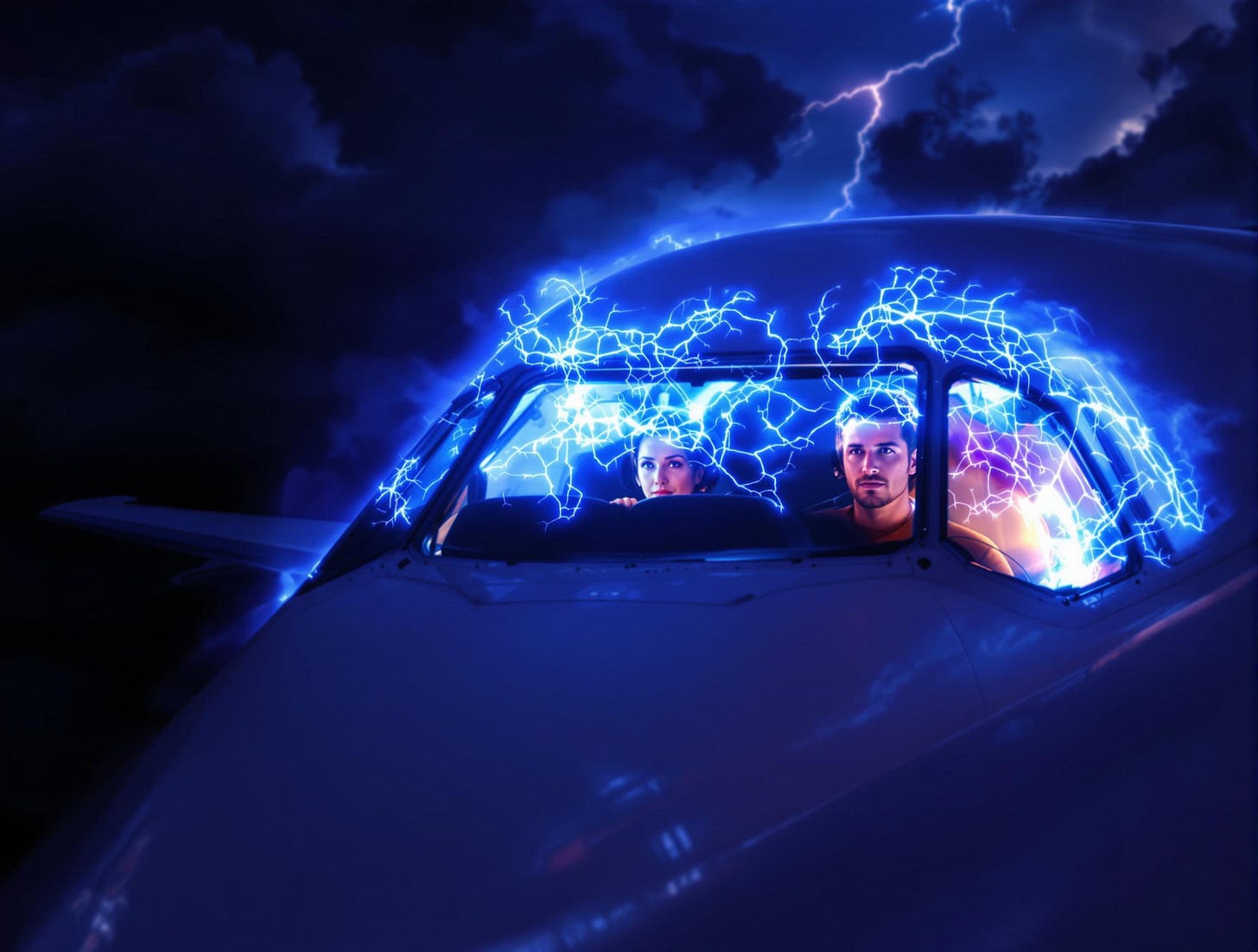Flying Safely Through Stormy Skies: How "We"Pilots Navigate Around Thunderstorms
A reassuring guide to understanding how modern aviation keeps you safe in severe weather
Introduction: Your Safety is Our Priority
If you've ever looked out an airplane window and seen towering storm clouds or watched lightning flash in the distance, you might have wondered: "How do pilots know where it's safe to fly?" The answer lies in one of aviation's most important safety tools weather radar.
Every day, pilots around the world use sophisticated weather detection technology to guide aircraft safely around dangerous storms. This isn't guesswork or hoping for the best, it's precise, scientific navigation that has made flying incredibly safe, even in challenging weather conditions.
This guide will help you understand how pilots detect storms, why they make the decisions they do, and how the aviation system works together to keep you safe. You'll discover that what might seem scary from a passenger's perspective is actually a well orchestrated safety process that pilots train for extensively.
How Pilots "See" Weather
The Magic of Weather Radar
Think of weather radar like a flashlight that can see through clouds. The airplane sends out invisible radio waves that bounce off raindrops and return to the aircraft. Just like how you can see objects when light bounces off them, pilots can "see" rain and storms by reading these returning signals.
The radar creates a colorful map on a screen in the cockpit, similar to the weather maps you see on TV. Different colors tell pilots different things:
🟩 Green means light rain usually smooth flying with maybe a gentle bump or two, like driving over a small pothole.
🟨 Yellow means moderate rain expect some bumps, similar to a boat crossing small waves.
🟥 Red means heavy rain and turbulence this is where pilots will steer around, just like you'd drive around a large pothole.
🟪 Magenta (bright purple-red) means severe weather—pilots stay far away from these areas, like avoiding a major construction zone on the highway.
What Pilots Can See That You Can't
From your window seat, you might see dark clouds and think they all look equally threatening. But pilots have a much clearer picture. Their radar can look inside clouds and see exactly where the heaviest rain is, how tall the storms are, and which direction they're moving.
It's like having X-ray vision for weather. While you see a wall of clouds, pilots see the gaps, the lighter areas, and the safe paths through or around the storms.
A Complete Weather Picture: Multiple Information Sources
Modern pilots don't rely on just one source of weather information—they have access to an incredible array of tools that work together to create a complete picture of weather conditions:
🤖 Onboard Weather Radar: This is like the airplane's main "weather eyes"—the system that can see inside clouds and identify exactly where the roughest conditions are located.
🛰 Live Satellite Weather on iPads: Many pilots now have tablets (like iPads) in the cockpit that show real-time weather from satellites. These show the "big picture" where storm systems are moving across entire regions, like having a weather map that updates every few minutes.
⚡ Lightning Detection Systems: Special equipment that can detect lightning strikes from hundreds of miles away, even when storms are too far to see. It's like having super-sensitive hearing that can detect thunder before you can hear it.
🌐 Real-Time Weather Data: Through satellite connections, pilots receive updated weather information throughout the flight current conditions, forecasts, and alerts, all delivered directly to the cockpit.
⚠️ Pilot Reports (PIREPs): Other pilots flying ahead of you radio back reports about what conditions are actually like "smooth ride at 35,000 feet" or "light bumps around Dallas." It's like having scouts reporting back about road conditions ahead.
📡 Ground-Based Weather Radar: Air traffic controllers have powerful weather radar systems on the ground that can see weather patterns across hundreds of miles. They share this information with pilots and help coordinate safe routes.
🌀 Turbulence Detection Systems: Some modern aircraft can actually detect rough air ahead before you feel it, allowing pilots to climb or descend to find smoother air.
⚙️ Weather Forecasting Models: Pilots have access to sophisticated computer models that predict exactly where storms will be hours in advance, helping them plan routes that avoid weather entirely.
This is like having a team of weather experts, scouts, and navigators all working together to find you the smoothest, safest path through the sky.
Understanding Thunderstorms: Nature's Powerhouses
Why Thunderstorms Form
Thunderstorms are like nature's air conditioning system. When the ground gets hot, warm air rises up high into the sky where it's much colder. This creates powerful air currents, imagine steam rising from your hot coffee, but thousands of times more powerful.
These air currents can bounce an airplane around, which is why pilots work so hard to avoid them. It's not dangerous to the airplane itself (modern aircraft are incredibly strong), but it can be very uncomfortable for passengers.
The Life of a Storm
Thunderstorms have three stages, like the life cycle of a fire:
Growing Stage: The storm is just getting started. The air is moving upward strongly, building the cloud higher and higher. This is usually the calmest stage for flying.
Mature Stage: This is when the storm is at its most powerful. Heavy rain, lightning, and strong air currents are all happening at once. This is the stage pilots work hardest to avoid.
Dying Stage: The storm is weakening, but it can still cause bumpy flying. Just because a storm looks less threatening doesn't mean it's completely safe to fly through.
Different Types of Storms
Isolated Storms: These are like single thunderclouds scattered across the sky. They're usually the easiest for pilots to navigate around, like driving around a single roadblock.
Storm Lines: Sometimes storms form in long lines, like a fence of bad weather. Pilots look for the weakest spots in these lines or fly around the entire system.
Severe Storms: These are the most powerful storms, with the strongest winds and heaviest rain. Pilots give these storms a very wide berth sometimes 20, 30, or even 50 miles of space.
How Pilots Make Weather Decisions
The Safety Buffer Zone
You know how you might avoid walking too close to a construction site, even if you could probably get by safely? Pilots do the same thing with storms, but with much more precise measurements.
Aviation rules require pilots to stay at least 20 miles away from the most severe storms. But experienced pilots often stay much farther away sometimes 40 or 50 miles. This might seem excessive, but it's like wearing both a seatbelt and having airbags in your car. Multiple layers of safety make flying incredibly secure.
Planning Ahead
Before your flight even begins, pilots spend considerable time studying weather reports and forecasts. They look at where storms are now, where they're expected to move, and how strong they might become. It's like checking the traffic report before you leave for work, but much more detailed.
Pilots also plan alternate routes and backup airports, just in case the weather changes unexpectedly. They might carry extra fuel to fly a longer route around storms or to wait at another airport if needed.
Making Changes During Flight
Sometimes weather can change after takeoff. When this happens, pilots work with air traffic controllers to find new, safe routes. This is why your flight might occasionally take longer than expected or why the pilot might announce a route change.
These changes are always made with safety as the top priority. A slightly longer flight is always better than an uncomfortable or unsafe one.
☄️ St. Elmo’s Fire
St. Elmo's fire is a weather phenomenon that appears as a blue or violet glow, often with a hissing or crackling sound, that occurs during thunderstorms or other electrically charged atmospheric conditions. Named after St. Erasmus of Formia (St. Elmo), the patron saint of sailors, this phenomenon happens when the atmosphere becomes electrically charged and creates a strong electric field. The electric field causes gas molecules in the air to break apart, and when they recombine, they emit light in a process called ionization. St. Elmo's fire typically appears on pointed objects like ship masts, church spires, aircraft wings, or even people's hair during storms, creating an eerie luminous display. Unlike lightning, St. Elmo's fire is a continuous discharge rather than a sudden flash, and while it can be startling to witness, it's generally harmless. Historically, sailors considered St. Elmo's fire to be a sign of protection from their patron saint, though it actually indicates dangerous electrical conditions in the atmosphere.
Working as a Team 🤝: Pilots and Air Traffic Control
Your Safety Network
Flying safely through weather isn't just about the pilots in your airplane. There's an entire network of people and technology working together to keep you safe:
Air Traffic Controllers watch weather patterns from the ground using powerful radar systems that can see storms from hundreds of miles away. They're like air traffic coordinators who help direct planes around weather, similar to how traffic reporters help drivers avoid accidents on the highway.
Weather Forecasters at the National Weather Service provide detailed predictions about where storms will develop and how they'll move. They issue special aviation weather warnings that pilots receive directly in the cockpit.
Airline Operations Centers (for commercial flights) have teams of people monitoring weather conditions 24/7. They can suggest route changes, delays, or alternate airports when needed. Think of them as mission control for your flight.
Other Pilots flying ahead of your route share real-time reports about what they're experiencing. These "pilot reports" or PIREPs are like getting text messages from friends who are driving ahead of you, telling you about traffic or road conditions.
Meteorologists who specialize in aviation weather provide detailed briefings and forecasts specifically designed for pilots. They understand exactly what weather conditions matter most for safe flying.
Satellite Weather Services provide real time weather data directly to aircraft through systems like SiriusXM weather. This means pilots can see live weather radar, lightning strikes, and storm movement right on their cockpit displays or iPads.
Ground-Based Weather Sensors at airports continuously monitor conditions like wind speed, direction, and visibility, sending this information directly to pilots and air traffic controllers.
Automated Weather Systems provide continuous updates about changing conditions at airports and along flight routes, ensuring pilots always have the most current information.
📣 Communication in Action
Throughout your flight, pilots are constantly receiving information from multiple sources and talking with air traffic controllers. Here's what's happening behind the scenes:
Continuous Weather Updates: Every few minutes, pilots receive updated weather information on their tablets and cockpit displays. Storm positions, intensity changes, and movement patterns are all tracked in real-time.
Pilot-to-Pilot Communication: Pilots listen to other aircraft reporting conditions ahead. You might hear something like: "Flight 456 reports smooth ride at flight level 370, but some light chop down at 350." This helps your pilots choose the best altitude.
Air Traffic Control Coordination: Controllers might say something like: "Flight 123, I'm showing a line of storms 30 miles ahead. We can route you 20 miles south or climb you to 39,000 feet to get above it." The pilot will look at their weather radar, check their tablet weather, and choose the safest option.
Real-Time Weather Sharing: Modern systems allow aircraft to automatically share turbulence and weather information with each other and with ground control, creating a live network of weather intelligence.
Dispatcher Support: For commercial flights, dispatchers on the ground continuously monitor the flight's progress and weather conditions, ready to suggest route changes or alternate airports if conditions change unexpectedly.
Automated Weather Alerts: Systems automatically alert pilots when severe weather develops along their route, often before it's even visible on radar.
You might hear the pilot announce "We're going to deviate slightly to the south to avoid some weather ahead" this is the result of all these information sources working together to identify the safest path.
Modern Aircraft: Built for Safety
Stronger Than You Think
Modern airplanes are incredibly robust. They're designed to handle much more stress than they'll ever encounter in normal flight. The bumps you feel during turbulence, while uncomfortable, are well within the airplane's safe limits.
Think of it like a tall building swaying slightly in the wind, it might feel strange if you're inside, but the building is designed to handle much stronger forces than it will ever actually experience.
Lightning Protection
If your aircraft is struck by lightning (which is rare and usually unnoticeable to passengers), modern planes are designed to let the electrical energy flow around the outside and exit safely. The airplane acts like a metal cage that protects everything inside.
Most lightning strikes cause no damage at all and don't even require any special action from the pilots.
Multiple Backup Systems
Commercial aircraft have backup systems for their backup systems, plus access to multiple independent sources of weather information:
Dual Weather Radars: Most aircraft have two separate weather radar systems. If one stops working, there's immediately another one ready to take over.
Multiple Weather Data Sources: Pilots receive weather information from onboard radar, satellite weather on their tablets, air traffic control radar, other aircraft reports, and ground-based weather stations all providing different pieces of the weather puzzle.
Independent Navigation Systems: If one system has problems, there are several others. Modern aircraft might have GPS, traditional navigation radios, and inertial navigation systems all working together.
Backup Communication Systems: Multiple radios and communication methods ensure pilots can always stay in touch with air traffic control and receive weather updates.
Redundant Weather Detection: In addition to radar, aircraft may have lightning detection systems, turbulence detection systems, and wind shear warning systems—each providing different types of safety information.
This redundancy means that even if something unexpected happens, there are multiple ways to keep you safe and multiple sources of weather information to help pilots make the best decisions.
What Those Announcements Really Mean
"We're Experiencing Some Light Chop"
This is pilot speak for small bumps caused by air moving at different speeds. It's like driving on a slightly rough road—noticeable but not concerning. The airplane handles this easily.
"We're Deviating Around Weather"
This means the pilots have spotted storms on their radar and are taking a different route to avoid them. This is exactly what you want them to do, it's proactive safety management.
"We're Going to Climb/Descend for Smoother Air"
Sometimes the bumpy air is only at certain altitudes. Pilots can often find smooth air by going higher or lower, just like finding a different lane on the highway to avoid traffic.
"We May Experience Some Turbulence"
This is the pilot's way of saying "buckle up, we might hit some bumps, but we're prepared for it." It's not a warning of danger, it's a heads-up to get comfortable and secure.
Your Role as a Passenger
Trust the Process
The most important thing you can do is trust that the aviation safety system works. Pilots spend years learning how to handle weather, and they practice these skills regularly in flight simulators. The decisions they make are based on extensive training and experience.
Stay Informed But Don't Worry
It's natural to be curious about what's happening during your flight. Feel free to listen to the pilot's announcements and look out the window. But remember that what looks scary to you might be completely routine to the flight crew.
Follow Instructions
When pilots ask you to return to your seat and fasten your seatbelt, it's for your safety and comfort. They're not predicting anything dangerous, they're just taking precautions to make sure you're secure if the ride gets bumpy.
Real Stories: How the System Works
A Successful Weather Avoidance
A flight from Chicago to Atlanta encountered a line of thunderstorms across their planned route. The pilots, working with air traffic control, found a path around the storms that added 20 minutes to the flight time. Passengers noticed the slight delay and the curved route on their flight tracking app, but they arrived safely and comfortably. This is the system working perfectly.
When Plans Change
A flight bound for Florida had to land at an alternate airport because storms moved over their destination. While passengers were initially disappointed by the delay, they were kept informed throughout the process. Once the storms passed, they completed their journey safely. The pilots made exactly the right decision, passenger convenience never comes before passenger safety.
Technology Saves the Day
A pilot noticed on their weather radar that a storm was developing rapidly along their route. At the same time, their iPad showed satellite weather confirming the storm's growth, and they received a pilot report from another aircraft that had just encountered turbulence in that area. Air traffic control also called to alert them about the developing weather cell. With all this information working together, the pilot requested a route change early and avoided the weather entirely. Passengers barely noticed anything unusual, which is exactly how good weather avoidance should work invisible to passengers but crucial for safety. This is a perfect example of how multiple weather information sources create layers of safety.
Modern Weather Information Integration
A flight from New York to Los Angeles had access to an incredible array of weather information throughout the journey. The pilots started with detailed weather briefings and satellite imagery showing storm systems across the country. During flight, their onboard radar painted a picture of nearby weather while their iPads displayed live satellite weather covering the entire continental United States. They received pilot reports from other aircraft about conditions ahead, wind shear alerts from automated systems at airports, and continuous updates from air traffic controllers with ground-based radar coverage. When a new storm system began developing over the Rocky Mountains, all these systems worked together to identify the threat early and plan a safe route around it. The result was a smooth, comfortable flight that arrived on time despite challenging weather across multiple states.
Weather Flying in Different Aircraft
Large Commercial Airlines
Big airliners have the most sophisticated weather detection equipment. They have powerful radar systems, real-time weather data, and highly trained crews. These aircraft can handle more challenging conditions than smaller planes and have more options for avoiding severe weather.
Regional Airlines
Smaller commercial aircraft have similar weather detection capabilities but may be more affected by turbulence due to their size. However, they're operated by equally well-trained pilots who follow the same safety procedures.
Private Aircraft
Even small private planes can have excellent weather detection equipment. While they may need to be more conservative about weather conditions, they follow the same basic principles of storm avoidance.
Seasonal Weather Patterns
Summer Thunderstorms
Summer is thunderstorm season in many parts of the world. These storms often develop in the afternoon and evening, which is why you might notice more weather-related delays during summer travel. Pilots are very familiar with these patterns and plan accordingly.
Winter Weather
Winter brings different challenges like ice and snow, but modern aircraft are well-equipped to handle these conditions. De-icing systems and careful planning keep winter flying safe.
Tropical Weather
In tropical regions, weather can change quickly. Pilots monitor conditions closely and are prepared to adjust plans as needed. The aviation system is experienced in dealing with tropical weather patterns.
The Future of Weather Detection
Better Technology
Weather detection technology keeps improving. Future systems will provide even more detailed information about storms and turbulence, making flying even safer and more comfortable.
Shared Information
Aircraft are beginning to share weather information with each other automatically. This means pilots will have access to real-time reports from other planes, creating an even better picture of weather conditions.
Improved Forecasting
Weather forecasting continues to get more accurate, allowing pilots to plan better routes and avoid weather more effectively.
⚡ When the Sky Gets Wild: Your Storm Stories
Picture this: You're cruising at 35,000 feet when suddenly the seatbelt sign flickers on. The captain's voice crackles through the intercom with those familiar words: "We're experiencing some turbulence due to thunderstorm activity ahead..."
Your stomach drops but is it from the plane's movement or that primal fear creeping in?
I want to hear from YOU: Are you one of those travelers who grips the armrest during every storm encounter, or do you actually find the raw power of nature oddly mesmerizing from above the clouds?
🛬 Your Turn to Taxi In:
I’ve shared the scene now I want to hear your version.
What’s the most unforgettable storm you’ve ever flown through?
Whether you were gripping the seat or gazing out in awe, hit reply and tell me:
What did it feel like?
What did you see?
And how did it change the way you think about flying?
I’m collecting storm stories from passengers and aviation pros alike, and a few might be featured in next month’s newsletter (with your permission). So don’t hold back, what’s your storm story? 🌩️✈️
Conclusion: You're in Good Hands
Flying through or around stormy weather might seem intimidating, but you're actually experiencing one of the most refined safety systems humans have ever created. Pilots spend years learning to read weather, aircraft are built to handle far more than they'll ever encounter, and air traffic controllers work continuously to keep everyone safe.
The next time you're on a flight and the pilot announces a weather deviation or you feel some turbulence, remember that these are signs of the safety system working properly. Pilots aren't taking chances, they're using sophisticated tools and extensive training to ensure your journey is as safe and comfortable as possible.
Every bump, every route change, and every delay is evidence that safety comes first in aviation. You can relax and enjoy your flight, knowing that you're protected by multiple layers of technology, training, and experience.
The sky might look threatening from your window, but from the pilot's perspective—armed with weather radar, training, and years of experience, it's a navigable environment with clear safe paths. Your job is simply to sit back, relax, and trust the process that has made commercial aviation one of the safest forms of travel ever invented.
Frequently Asked Questions
Q: Is it safe to fly if there are storms at my destination? A: Yes, pilots and air traffic controllers work together to find safe approaches to airports, even when there are storms in the area. If conditions aren't safe for landing, flights will wait or divert to alternate airports.
Q: Why do flights get delayed for weather that doesn't look that bad? A: Pilots can see weather conditions that aren't visible to passengers. Their weather radar might show severe conditions inside clouds that look harmless from the outside.
Q: What if we have to fly through a storm? A: Pilots work very hard to avoid flying through storms. In the rare cases where some weather cannot be avoided, pilots choose the lightest, safest areas and adjust their speed and altitude for the smoothest possible ride.
Q: How far in advance can pilots see bad weather? A: Weather radar can typically see storms up to 300 miles away, giving pilots plenty of time to plan safe routes around them.
Remember: Every flight is planned and executed with your safety as the absolute top priority. The aviation industry's outstanding safety record is no accident—it's the result of careful planning, excellent training, and sophisticated technology all working together to protect you. Pilot Nick











